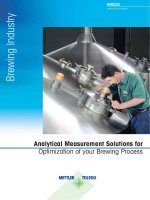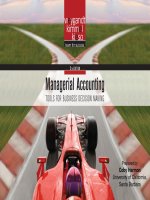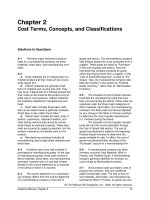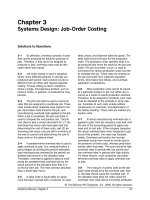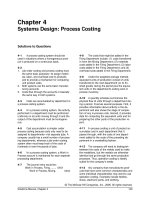Solutions to question managerial accounting ch04 process cosing
Bạn đang xem bản rút gọn của tài liệu. Xem và tải ngay bản đầy đủ của tài liệu tại đây (137.1 KB, 67 trang )
Chapter 4
Systems Design: Process Costing
Solutions to Questions
4-1
A process costing system should be
used in situations where a homogeneous product is produced on a continuous basis.
4-2
1. Job-order costing and process costing have
the same basic purposes—to assign materials, labor, and overhead cost to products
and to provide a mechanism for computing
unit product costs.
2. Both systems use the same basic manufacturing accounts.
3. Costs flow through the accounts in basically
the same way in both systems.
4-3
Costs are accumulated by department in
a process costing system.
4-4
In a process costing system, the activity
performed in a department must be performed
uniformly on all units moving through it and the
output of the department must be homogeneous.
4-5
Cost accumulation is simpler under
process costing because costs only need to be
assigned to departments—not separate jobs. A
company usually has a small number of processing departments, whereas a job-order costing
system often must keep track of the costs of
hundreds or even thousands of jobs.
4-6
In a process costing system, a Work in
Process account is maintained for each separate
processing department.
4-7
The journal entry would be:
Work in Process, Firing ........ XXXX
Work in Process, Mixing .
XXXX
4-8
The costs that might be added in the
Firing Department include: (1) costs transferred
in from the Mixing Department; (2) materials
costs added in the Firing Department; (3) labor
costs added in the Firing Department; and (4)
overhead costs added in the Firing Department.
4-9
Under the weighted-average method,
equivalent units of production consist of units
transferred to the next department (or to finished goods) during the period plus the equivalent units in the department’s ending work in
process inventory.
4-10 A quantity schedule summarizes the
physical flow of units through a department during a period. It serves several purposes. First, it
provides information about activity in the department and also shows the stage of completion of any in-process units. Second, it provides
data for computing the equivalent units and for
preparing the other parts of the production report.
4-11 In process costing a unit of product accumulates cost in each department that it
passes through, with the costs of one department added to the costs of the preceding department in a snowballing fashion.
4-12 The company will want to distinguish
between the costs of the metals used to make
the medallions, but the medals are otherwise
identical and go through the same production
processes. Thus, operation costing is ideally
suited for the company’s needs.
4-13 Any company that manufactures products that have some common characteristics and
some individual characteristics may want to use
operation costing. Examples include textiles,
shoes, electronic parts, and clothing.
© The McGraw-Hill Companies, Inc., 2006. All rights reserved.
Solutions Manual, Chapter 4
143
4-14 Under the FIFO method, units transferred out are divided into two parts. One part
consists of the units in the beginning inventory.
Only the work needed to complete these units is
shown as part of the equivalent units for the
current period. The other part of the units transferred out consists of the units started and completed during the current period; these units are
shown as a separate amount in the equivalent
units computation under the FIFO method.
4-15 Under the FIFO method, units transferred out are divided into two groups. The first
group consists of units from the beginning work
in process inventory. The second group consists
of units started and completed during the period.
4-16 The FIFO method is superior to the
weighted-average method for cost control because current performance should be measured
in relation to costs of the current period only,
and the weighted-average method mixes these
costs in with costs of the prior period. Thus, under the weighted-average method, the department’s apparent performance in the current period is influenced to some extent by what happened in a prior period.
© The McGraw-Hill Companies, Inc., 2006. All rights reserved.
144
Managerial Accounting, 11th Edition
Exercise 4-1 (20 minutes)
a. To record issuing raw materials for use in production:
Work in Process—Molding Department ........
23,000
Work in Process—Firing Department............
8,000
Raw Materials......................................
31,000
b. To record direct labor costs incurred:
Work in Process—Molding Department ........
Work in Process—Firing Department............
Wages Payable ....................................
12,000
7,000
19,000
c. To record applying manufacturing overhead:
Work in Process—Molding Department ........
Work in Process—Firing Department............
Manufacturing Overhead ......................
25,000
37,000
62,000
d. To record transfer of unfired, molded bricks from the Molding Department to the Firing Department:
Work in Process—Firing Department............
57,000
Work in Process—Molding Department ..
57,000
e. To record transfer of finished bricks from the Firing Department to the
finished bricks warehouse:
Finished Goods ..........................................
103,000
Work in Process—Firing Department .....
103,000
f. To record Cost of Goods Sold:
Cost of Goods Sold.....................................
Finished Goods ....................................
101,000
101,000
© The McGraw-Hill Companies, Inc., 2006. All rights reserved.
Solutions Manual, Chapter 4
145
Exercise 4-2 (10 minutes)
Weighted-Average Method
Equivalent Units (EU)
Materials Conversion
Units transferred out ....................... 190,000
Work in process, ending:
15,000 units × 80%...................... 12,000
15,000 units × 40%......................
Equivalent units .............................. 202,000
190,000
6,000
196,000
© The McGraw-Hill Companies, Inc., 2006. All rights reserved.
146
Managerial Accounting, 11th Edition
Exercise 4-3 (10 minutes)
FIFO Method
Equivalent Units (EU)
Materials Conversion
Work in process, beginning:
30,000 units × 35%* .............................. 10,500
30,000 units × 70%* ..............................
Started and completed during October** .... 160,000
Work in process, ending:
15,000 units × 80%................................ 12,000
15,000 units × 40%................................
Equivalent units ........................................ 182,500
21,000
160,000
6,000
187,000
* Work needed to complete these units.
** 175,000 units started – 15,000 units in ending work in process
= 160,000 started and completed
© The McGraw-Hill Companies, Inc., 2006. All rights reserved.
Solutions Manual, Chapter 4
147
Exercise 4-4 (15 minutes)
Weighted-Average Method
Tons
1. Work in process, June 1 .................................................
Started into production during the month ........................
Total tons in process......................................................
Deduct work in process, June 30.....................................
Completed and transferred out during the month .............
20,000
190,000
210,000
30,000
180,000
2. Tons to be accounted for:
Work in process, June 1 (materials 90% complete,
labor and overhead 80% complete) ...........................
Started into production during the month......................
Total tons to be accounted for ........................................
20,000
190,000
210,000
Tons accounted for as follows:
Transferred out during the month.................................
Work in process, June 30 (materials 60% complete,
labor and overhead 40% complete) ...........................
Total tons accounted for ................................................
180,000
30,000
210,000
© The McGraw-Hill Companies, Inc., 2006. All rights reserved.
148
Managerial Accounting, 11th Edition
Exercise 4-5 (15 minutes)
FIFO Method
1. The number of tons completed and transferred out during the month is
the same regardless of the costing method used. Thus, as in the similar
exercise that is based on the weighted-average method, 180,000 tons
would have been completed and transferred out. However, under the
FIFO method we must break this down between the tons that were
completed from the beginning inventory and the tons started and completed during the current period. This breakdown is shown in Part 2 below:
2. Tons to be accounted for:
Work in process, June 1 (materials 90% complete; labor and overhead 80% complete) ........... 20,000
Started into production during the month ............... 190,000
Total tons to be accounted for ................................. 210,000
Tons accounted for as follows:
Transferred out during the month:
Tons from the beginning inventory ...................... 20,000
Tons started and completed during the month ..... 160,000 *
Work in process, June 30 (materials 60% complete; labor and overhead 40% complete) ........... 30,000
Total tons accounted for.......................................... 210,000
* 190,000 tons started into production – 30,000 tons in ending work
in process = 160,000 tons started and completed.
© The McGraw-Hill Companies, Inc., 2006. All rights reserved.
Solutions Manual, Chapter 4
149
Exercise 4-6 (15 minutes)
Weighted-Average Method
1.
Materials
Work in process, May 1 ................... $ 18,000
Cost added during May.................... 238,900
Total cost (a).................................. $256,900
Equivalent units of production (b) ....
Cost per equivalent unit (a) ÷ (b).....
2.
35,000
$7.34
Labor
$ 5,500
80,300
$85,800
33,000
$2.60
Overhead
$ 27,500
401,500
$429,000
33,000
$13.00
Cost per EU for materials.......... $ 7.34
Cost per EU for labor................
2.60
Cost per EU for overhead ......... 13.00
Total cost per EU ..................... $22.94
© The McGraw-Hill Companies, Inc., 2006. All rights reserved.
150
Managerial Accounting, 11th Edition
Exercise 4-7 (20 minutes)
Weighted-Average Method
1. Computation of the total cost per EU:
Cost per EU for materials.......... $12.50
Cost per EU for labor................
3.20
Cost per EU for overhead .........
6.40
Total cost per EU ..................... $22.10
2. Computation of equivalent units in ending inventory:
Units in ending inventory ............
Percentage completed ................
Equivalent units of production.....
Materials
3,000
80%
2,400
Labor
3,000
60%
1,800
Overhead
3,000
60%
1,800
3. Cost Reconciliation
Total
Cost
Cost accounted for as follows:
Transferred to the next department: 25,000 units at
$22.10 per unit.................... $552,500
Work in process, ending:
Materials, at $12.50 per EU .. 30,000
Labor, at $3.20 per EU .........
5,760
Overhead, at $6.40 per EU ... 11,520
Total work in process.............. 47,280
Total cost accounted for ............ $599,780
Materials
Labor
Overhead
25,000 25,000 25,000
2,400
1,800
1,800
© The McGraw-Hill Companies, Inc., 2006. All rights reserved.
Solutions Manual, Chapter 4
151
Exercise 4-8 (10 minutes)
FIFO Method
1.
Materials
Labor
Cost added during May (a) ............. $193,320 $62,000
Equivalent units of production (b) ...
27,000 25,000
Cost per equivalent unit (a) ÷ (b)....
$7.16
$2.48
2. Cost per EU for materials......
Cost per EU for labor............
Cost per EU for overhead......
Total cost per EU .................
Overhead
$310,000
25,000
$12.40
$ 7.16
2.48
12.40
$22.04
© The McGraw-Hill Companies, Inc., 2006. All rights reserved.
152
Managerial Accounting, 11th Edition
Exercise 4-9 (45 minutes)
FIFO Method
1. Computation of the total cost per EU:
Cost per EU for material ...........
Cost per EU for conversion .......
Total cost per EU .....................
$25.40
18.20
$43.60
2. Computation of equivalent units in ending inventory:
Units in ending inventory ..........
Percentage completed ..............
Equivalent units of production...
Materials
300
70%
210
Conversion
300
60 %
180
3. Computation of equivalent units required to complete the beginning inventory:
Units in beginning inventory .....
Percentage uncompleted ..........
Equivalent units of production...
Materials
400
20%
80
Conversion
4. Units transferred to the next department .............
Units from the beginning inventory......................
Units started and completed during the period .....
400
60 %
240
3,100
400
2,700
© The McGraw-Hill Companies, Inc., 2006. All rights reserved.
Solutions Manual, Chapter 4
153
Exercise 4-9 (continued)
5. Cost Reconciliation
Equivalent Units
Total Cost Materials Conversion
Cost accounted for as follows:
Transferred to the next department:
From the beginning inventory:
Cost in the beginning inventory.............................. $ 11,040
Cost to complete these units:
Materials at $25.40 per EU .................................
2,032
Conversion at $18.20 per EU ..............................
4,368
Total cost from beginning inventory ..........................
17,440
Units started and completed this month at $43.60
per unit ................................................................
117,720
Total cost transferred to the next department...............
135,160
Work in process, ending:
Materials at $25.40 per EU .......................................
5,334
Conversion at $18.20 per EU ....................................
3,276
Total work in process, ending......................................
8,610
Total cost accounted for.............................................. $143,770
80
2,700
210
240
2,700
180
© The McGraw-Hill Companies, Inc., 2006. All rights reserved.
154
Managerial Accounting, 11th Edition
Exercise 4-10 (10 minutes)
Work in Process—Cooking.................................
Raw Materials Inventory ..............................
42,000
Work in Process—Cooking.................................
Work in Process—Molding .................................
Wages Payable............................................
50,000
36,000
Work in Process—Cooking.................................
Work in Process—Molding .................................
Manufacturing Overhead..............................
75,000
45,000
Work in Process—Molding .................................
Work in Process—Cooking............................
160,000
Finished Goods.................................................
Work in Process—Molding ............................
240,000
42,000
86,000
120,000
160,000
240,000
© The McGraw-Hill Companies, Inc., 2006. All rights reserved.
Solutions Manual, Chapter 4
155
Exercise 4-11 (15 minutes)
Weighted-Average Method
Quantity
Schedule
Pounds to be accounted for:
Work in process, July 1 (materials
100% complete, conversion 30%
complete) ....................................
20,000
Started into production during July... 380,000
Total pounds to be accounted for ....... 400,000
Pounds accounted for as follows:
Transferred to next department
during July*................................. 375,000
Work in process, July 31 (materials
100% complete, conversion 60%
complete) ....................................
25,000
Total pounds accounted for................ 400,000
Equivalent Units (EU)
Materials Conversion
375,000
375,000
25,000
400,000
15,000
390,000
* 20,000 + 380,000 – 25,000 = 375,000
© The McGraw-Hill Companies, Inc., 2006. All rights reserved.
156
Managerial Accounting, 11th Edition
Exercise 4-12 (15 minutes)
FIFO Method
Quantity
Schedule
Pounds to be accounted for:
Work in process, July 1 (materials 100% complete, conversion 30% complete) ................. 20,000
Started into production during
July ......................................... 380,000
Total pounds to be accounted for ... 400,000
Pounds accounted for as follows
Transferred to next department:
From the beginning inventory.... 20,000
Started and completed this
month** ............................... 355,000
Work in process, July 31 (materials 100% complete, conversion 60% complete) ................. 25,000
Total pounds accounted for............ 400,000
Equivalent Units (EU)
Materials
Conversion
0
14,000 *
355,000
355,000
25,000
380,000
15,000
384,000
* Work required to complete these units:
20,000 pounds × (100% – 30%) = 14,000 pounds.
** 380,000 pounds started – 25,000 pounds in ending work in process
inventory = 355,000 pounds started and completed this month.
© The McGraw-Hill Companies, Inc., 2006. All rights reserved.
Solutions Manual, Chapter 4
157
Exercise 4-13 (20 minutes)
Weighted-Average Method
1. For the sake of brevity, only the portion of the quantity schedule from which the equivalent units are
computed is shown below.
Units accounted for as follows:
Transferred to the next process.............
Work in process, May 31 (materials
100% complete, conversion 30%
complete)..........................................
Total units accounted for.........................
2.
Quantity
Schedule
Equivalent Units (EU)
Materials Conversion
175,000
175,000
175,000
10,000
185,000
10,000
185,000
3,000
178,000
Total
Cost
Cost to be accounted for:
Work in process, May 1.......................... $ 5,500
Cost added by the department ............... 406,000
Total cost to be accounted for (a) .............$411,500
Equivalent units (b)..................................
Cost per equivalent unit (a) ÷ (b)..............
Materials
$ 1,500
54,000
$55,500
185,000
$0.30 +
Conversion
$ 4,000
352,000
$356,000
178,000
$2.00 =
Whole
Unit
$2.30
© The McGraw-Hill Companies, Inc., 2006. All rights reserved.
158
Managerial Accounting, 11th Edition
Exercise 4-14 (15 minutes)
Weighted-Average Method
Total
Cost
Cost accounted for as follows:
Transferred to the next process
(175,000 units × $2.30 per
unit)........................................ $402,500
Work in process, May 31:
Materials, at $0.30 per EU.........
3,000
Conversion, at $2.00 per EU......
6,000
Total work in process ..................
9,000
Total cost accounted for ................ $411,500
Equivalent Units (EU)
Materials Conversion
175,000
10,000
175,000
3,000
© The McGraw-Hill Companies, Inc., 2006. All rights reserved.
Solutions Manual, Chapter 4
159
Exercise 4-15 (20 minutes)
FIFO Method
1. Quantity schedule and equivalent units:
Quantity
Schedule
Units to be accounted for:
Work in process, May 1 (materials 100% complete, conversion 40% complete)........................
5,000
Started into production ......................................... 180,000
Total units to be accounted for ................................ 185,000
Units accounted for as follows:
Transferred to the next process:
From the beginning inventory .............................
5,000
Started and completed this month**................... 170,000
Work in process, May 31 (materials 100% complete, conversion 30% complete)........................ 10,000
Total units accounted for......................................... 185,000
Equivalent Units (EU)
Materials Conversion
0
170,000
3,000 *
170,000
10,000
180,000
3,000
176,000
* Work needed to complete the units in beginning inventory.
** 180,000 units started into production – 10,000 units in ending work in process = 170,000 units
started and completed
© The McGraw-Hill Companies, Inc., 2006. All rights reserved.
160
Managerial Accounting, 11th Edition
Exercise 4-15 (continued)
2.
Total
Cost
Cost to be accounted for:
Work in process, May 1......................... $ 5,500
Cost added by the department (a) ......... 406,000
Total cost to be accounted for.................. $411,500
Equivalent units (b).................................
Cost per equivalent unit (a) ÷ (b).............
Materials
Conversion
$54,000
$352,000
180,000
$0.30 +
Whole
Unit
176,000
$2.00 = $2.30
© The McGraw-Hill Companies, Inc., 2006. All rights reserved.
Solutions Manual, Chapter 4
161
Exercise 4-16 (20 minutes)
FIFO Method
Total
Cost
Cost accounted for as follows:
Transferred to the next process:
From the beginning inventory:
Cost in the beginning inventory..... $ 5,500
Cost to complete these units:
Materials, at $0.30 per EU ........
0
Conversion, at $2.00 per EU .....
6,000
Total cost from beginning inventory.. 11,500
Units started and completed this
month: 170,000 units × $2.30
per unit........................................ 391,000
Total cost transferred......................... 402,500
Work in process, May 31:
Materials, at $0.30 per EU................
3,000
Conversion, at $2.00 per EU.............
6,000
Total work in process .........................
9,000
Total cost accounted for ....................... $411,500
Equivalent Units (EU)
Materials Conversion
0
170,000
10,000
3,000
170,000
3,000
© The McGraw-Hill Companies, Inc., 2006. All rights reserved.
162
Managerial Accounting, 11th Edition
Exercise 4-17 (20 minutes)
Weighted-Average Method
1.
Units to be accounted for:
Work in process, beginning
(materials 80% complete,
labor and overhead 60%
complete) ............................
Started into production............
Total units to be accounted for...
Quantity
Schedule
5,000
45,000
50,000
Units accounted for as follows:
Transferred to the next department ............................. 42,000
Work in process, ending (materials 75% complete, labor
and overhead 50% complete) .................................. 8,000
Total units accounted for ........... 50,000
Equivalent Units (EU)
Materials Labor Overhead
42,000
42,000
42,000
6,000
48,000
4,000
46,000
4,000
46,000
© The McGraw-Hill Companies, Inc., 2006. All rights reserved.
Solutions Manual, Chapter 4
163
Exercise 4-17 (continued)
2.
Total
Cost
Materials
Labor
Cost to be accounted for:
Work in process, beginning ......... $ 7,150 $ 4,320 $ 1,040
Cost added by the department .... 106,550 52,800 21,500
Total cost to be accounted for (a) .. $113,700 $57,120 $22,540
Equivalent units (b).......................
Cost per equivalent unit (a) ÷ (b)...
48,000
$1.19
46,000
$0.49 +
Overhead
Whole
Unit
$ 1,790
32,250
$34,040
46,000
$0.74 =
$2.42
© The McGraw-Hill Companies, Inc., 2006. All rights reserved.
164
Managerial Accounting, 11th Edition
Exercise 4-18 (20 minutes)
FIFO Method
1.
Units to be accounted for:
Work in process, beginning (materials 80% complete, labor and overhead 60% complete) ............
Started into production..........................................
Total units accounted for .........................................
Units accounted for as follows:
Transferred to the next department:
From the beginning inventory..............................
Started and completed this month** ...................
Work in process, ending (materials 75% complete,
labor and overhead 50% complete) .....................
Total units accounted for .........................................
Quantity
Schedule
5,000
45,000
50,000
Equivalent Units (EU)
Materials
Labor
Overhead
5,000
37,000
1,000 * 2,000 *
37,000
37,000
2,000 *
37,000
8,000
50,000
6,000
44,000
4,000
43,000
4,000
43,000
* Work required to complete the beginning inventory.
** 45,000 units started into production – 8,000 units in ending work in process
= 37,000 started and completed
© The McGraw-Hill Companies, Inc., 2006. All rights reserved.
Solutions Manual, Chapter 4
165
Exercise 4-18 (continued)
2.
Total
Cost
Materials
Cost to be accounted for:
Work in process, beginning .......... $ 7,150
Cost added during the month (a).. 106,550 $52,800
Total cost to be accounted for......... $113,700
Equivalent units (b)........................
Cost per equivalent unit (a) ÷ (b)....
44,000
$1.20 +
Labor
Overhead
$21,500
$32,250
43,000
$0.50 +
43,000
$0.75 =
Whole
Unit
$2.45
© The McGraw-Hill Companies, Inc., 2006. All rights reserved.
166
Managerial Accounting, 11th Edition
Problem 4-19 (45 minutes)
Weighted-Average Method
1., 2., and 3.
Quantity Schedule and Equivalent Units
Quantity
Schedule
Units to be accounted for:
Work in process, May 1 (materials 100% complete; labor and overhead 80% complete)........ 10,000
Started into production...................................... 100,000
Total units to be accounted for............................. 110,000
Equivalent Units (EU)
Materials Labor Overhead
Units accounted for as follows:
Transferred out ................................................
95,000 95,000
Work in process, May 31 (materials 60% complete; labor and overhead 20% complete)........
15,000
9,000
Total units accounted for ..................................... 110,000 104,000
95,000
95,000
3,000
98,000
3,000
98,000
© The McGraw-Hill Companies, Inc., 2006. All rights reserved.
Solutions Manual, Chapter 4
167

